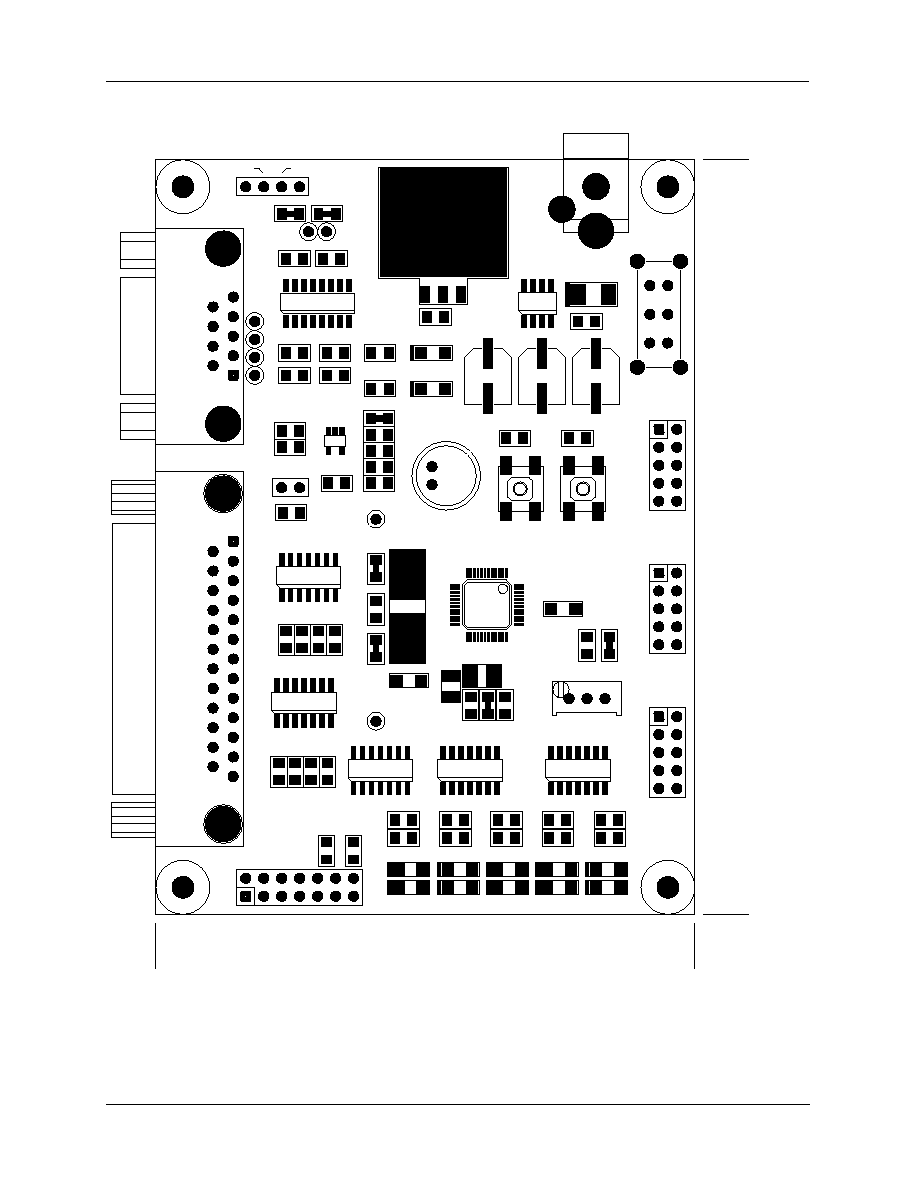
© Motorola, Inc., 2003. All rights reserved.
56F800 Demonstration Board
User's Manual
Order this document by
DSP56F800DBUM/D
Rev. 0, 03/28/2003


MOTOROLA
Table of Contents
i
Preface
Chapter 1
Introduction
1.1
56F800 Demonstration Board Features . . . . . . . . . . . . . . . . . . . . . . . . . . . . . . . . 1-1
1.2
SPECIFICATIONS . . . . . . . . . . . . . . . . . . . . . . . . . . . . . . . . . . . . . . . . . . . . . . . 1-3
Chapter 2
Technical Summary
2.1
OPTIONS. . . . . . . . . . . . . . . . . . . . . . . . . . . . . . . . . . . . . . . . . . . . . . . . . . . . . . . 2-1
2.1.1
HOST_ENABLE . . . . . . . . . . . . . . . . . . . . . . . . . . . . . . . . . . . . . . . . . . . . . . 2-1
2.1.2
CUT_AWAY Options . . . . . . . . . . . . . . . . . . . . . . . . . . . . . . . . . . . . . . . . . . 2-1
2.2
PORTS AND CONNECTORS . . . . . . . . . . . . . . . . . . . . . . . . . . . . . . . . . . . . . . 2-2
2.2.1
PWR Jack . . . . . . . . . . . . . . . . . . . . . . . . . . . . . . . . . . . . . . . . . . . . . . . . . . . . 2-2
2.2.2
POWER PORT . . . . . . . . . . . . . . . . . . . . . . . . . . . . . . . . . . . . . . . . . . . . . . . . 2-2
2.2.3
GPIO / SERIAL . . . . . . . . . . . . . . . . . . . . . . . . . . . . . . . . . . . . . . . . . . . . . . . 2-2
2.2.4
TIMER / PWM . . . . . . . . . . . . . . . . . . . . . . . . . . . . . . . . . . . . . . . . . . . . . . . . 2-3
2.2.5
ADC Port . . . . . . . . . . . . . . . . . . . . . . . . . . . . . . . . . . . . . . . . . . . . . . . . . . . . 2-3
2.2.6
COM1 . . . . . . . . . . . . . . . . . . . . . . . . . . . . . . . . . . . . . . . . . . . . . . . . . . . . . . . 2-3
2.2.7
JTAG / OnCE . . . . . . . . . . . . . . . . . . . . . . . . . . . . . . . . . . . . . . . . . . . . . . . . . 2-3
2.2.8
P1 - HOST JTAG . . . . . . . . . . . . . . . . . . . . . . . . . . . . . . . . . . . . . . . . . . . . . . 2-4
2.3
USER FEATURES . . . . . . . . . . . . . . . . . . . . . . . . . . . . . . . . . . . . . . . . . . . . . . . 2-4
2.3.1
MICROPHONE . . . . . . . . . . . . . . . . . . . . . . . . . . . . . . . . . . . . . . . . . . . . . . . 2-4
2.3.2
POTENTIOMETER (POT) - R12 . . . . . . . . . . . . . . . . . . . . . . . . . . . . . . . . . 2-5
2.4
Indicators . . . . . . . . . . . . . . . . . . . . . . . . . . . . . . . . . . . . . . . . . . . . . . . . . . . . . . . 2-5
Appendix A
56F800 Demonstration Board Schematics
Table of Contents

ii
56F800 Demonstration Board User's Manual
MOTOROLA

MOTOROLA
List of Figures
iii
1-1
56F800 Demonstration Board. . . . . . . . . . . . . . . . . . . . . . . . . . . . . . . . . . 1-2
2-1
Power Port. . . . . . . . . . . . . . . . . . . . . . . . . . . . . . . . . . . . . . . . . . . . . . . . . 2-2
A-1
56F800 Demonstration Board. . . . . . . . . . . . . . . . . . . . . . . . . . . . . . . . . . A-2
List of Figures

iv
56F800 Demonstration Board User's Manual
MOTOROLA

MOTOROLA
List of Tables
i
2-1
CUT_AWAY Options . . . . . . . . . . . . . . . . . . . . . . . . . . . . . . . . . . . . . . . 2-1
2-2
Indicators. . . . . . . . . . . . . . . . . . . . . . . . . . . . . . . . . . . . . . . . . . . . . . . . . . 2-5
List of Tables

ii
56F800 Demonstration Board User's Manual
MOTOROLA

MOTOROLA
Preface
iii
Preface
This reference manual describes in detail the hardware on the 56F800 Demonstration
Board.
Audience
This document is intended for application developers who are creating software for
devices using the Motorola 56F800 Demonstration Board.
Organization
This manual is organized into two chapters and one appendix.
∑
Chapter 1, Introduction -
provides an overview of the Demonstration Board and its
features
.
∑
Chapter 2, Technical Summary -
describes the 56F800 Demonstration Board in
detail.
∑
Appendix A, 56F800 Demonstration Board Schematics -
contains the schematics of the
56F800 Demonstration Board.
Suggested Reading
Related documentation for the 56F800 family of hybrid controllers may be found at:
http://www.motorola.com/dsp

iv
56F800 Demonstration Board User's Manual
MOTOROLA
Notation Conventions
This manual uses the following notational conventions:
Typeface, Symbol or
Term
Meaning
Examples
Typeface, Symbol or
Term
Courier
Monospaced Type
Code examples
//Process command
for line flash
Courier
Monospaced Type
Italic
Directory names,
project names,
calls,
functions,
statements,
procedures,
routines,
arguments,
file names,
applications,
variables,
directives,
code snippets
APIs
in text
...and contains these core
directories:
applications contains
applications software...
...CodeWarrior project,
3des.mcp is...
...the pConfig argument....
...defined in the C header
file, aec.h....
Italic
Bold
Reference sources,
paths,
emphasis
...refer to the Target-
ing DSP56F80x Plat-
form
manual....
...see: C:\Program
Files\Motor-
ola\Embedded
SDK\help\tutorials
Bold
Blue Text
Linkable
...refer to
Chapter 7
,
License....
Blue Text
Number
Any number is consid-
ered a positive value,
unless preceded by a
minus symbol to sig-
nify a negative value
3V
-10
DES
-1
Number
ALL CAPITAL LET-
TERS
# defines/
defined constants
# define
INCLUDE_STACK_CH
ECK
ALL CAPITAL LETTERS
Brackets [...]
Function keys
...by pressing function
key [F7]
Brackets [...]

MOTOROLA
Preface
v
Cautionary Notes
1. Electrostatic Discharge (ESD) prevention measures should be applied whenever
handling this product. ESD damage is not a warranty repair item.
2. EMC Information on the 56F800 Demonstration Board:
a. This product as shipped from the factory with associated power supplies and
cables, has been tested and meets with requirements of CE and the FCC as a
CLASS A product.
b. This product is designed and intended for use as a development platform for
hardware or software in an educational or professional laboratory.
c. In a domestic environment this product may cause radio interference in which
case the user may be required to take adequate prevention measures.
d. Attaching additional wiring to this product or modifying the products operation
from the factory default as shipped may effect its performance and also cause
interference with other apparatus in the immediate vicinity. If such interference
is detected, suitable mitigating measures should be taken.
Terminology
This development board applies option selection jumpers. Terminology for application of
the option jumpers is as follows:
Jumper on, in, or installed = jumper is a plastic shunt that fits across 2 pins and the shunt is
installed so that the 2 pins are connected with the shunt.
Jumper off, out, or idle = jumper or shunt is installed so that only 1 pin holds the shunt, no
2 pins are connected, or jumper is removed. It is recommended that the jumpers be idled
by installing on 1 pin so they will not be lost.
This development board applies CUT_AWAY option selections. These option selections
apply surface mount resistor locations with a printed circuit board trace connecting both
component pads. This type connection places an equivalent 0-ohm type resistor in series
with the I/O signal and the user component or I/O connector on the board. These
connections maybe cut with a razor blade or similar type knife between the component
pads to isolate the default connection provided. Reconnection of the cut-away type pads
can be made by either installing a 0 ohm 0805 size surface mount resistor or a small wire
jumper on the component pads.

vi
56F800 Demonstration Board User's Manual
MOTOROLA
Definitions, Acronyms, and Abbreviations
Definitions, acronyms and abbreviations for terms used in this document are defined
below for reference.
References
The following sources were referenced to produce this manual:
DSP56800 Family Manual, Motorola
DSP56F80x User's Manual, Motorola
Technical Data, 56F801 16-Bit Hybrid Controller, Motorola
ADC
Analog-to-Digital Converter
CTS
Clear To Send
ESD
Electrostatic Discharge
GPIO
General Purpose Input and Output Port
JTAG
Joint Test Action Group. A bus protocol/interface used for test and
debug.
OnCE
TM
On-Chip Emulation, a debug bus and port created by Motorola to enable
designers to create a low-cost hardware interface for a professional
quality debug environment.
PC
Personal Computer
POT
Potentiometer
PWM
Pulse Width Modulation
RTS
Request To Send

MOTOROLA
Introduction
1-1
Chapter 1
Introduction
The 56F800 Demonstration Board is used to demonstrate the abilities of the 56F800
family and to provide a hardware tool allowing the development of applications that use
the 56F800 devices.
1.1 56F800 Demonstration Board
Features
∑
56F801FA60 (60 MHz version)
∑
RESET Switch
∑
IRQ Switch
∑
GPIO / SERIAL Port (10 pin) *
∑
TIMER / PWM Port (10 Pin) *
∑
ADC Port (10 Pin) *
∑
JTAG / OnCE Port (14 pin) *
∑
Host JTAG Port (P1- DB25P)
∑
COM1 Port - SCI to RS232 (DB9S) *
∑
PWR Jack supply connector
∑
Power Port *
∑
Power Indicator
∑
10 User Indicators
∑
User Potentiometer (R12)
∑
Microphone with amplifier
∑
Crystal Reference (Y1) *
* All components may not be installed at the factory. The user may install the components
to apply associated feature.
The 56F800 Demonstration Board is detailed in
Figure 1-1
.

1-2
56F800 Demonstration Board User's Manual
MOTOROLA
Figure 1-1. 56F800 Demonstration Board
2
R2
L1
C3
+
C8
1
D3
U3
74ACT05
1
R12
JTAG
1
Y1
C5
U5
74LCX125
U4
74ACT125
JP1
U2
74ACT05
IRQ
1
D11
PWR
TIMER
-PORT
1
U6
74ACT00
15
9
6
COM1
GND
VDDA
+3.3V
+VIN
MICRO
PHONE
U7
ON_OFF
VR1
U1
DSP56F801
3
4
5
6
7
GND
C1
C2
R3
R5
R4
R6
R7
R8
R9
R10
R11
R13
R14
C6
R1
R16
R17
R23
R24
R25
R27
R26
R28
R22
R21
R15
R19
R20
C9
C11
C15
C14
C16
C17
C18
R34
C12
R30
R29
R31
R32
C13
R33
C10
C7
4
6
9
RTS
CTS
GND
P1
13
25
1
14
D5
D6
D7
D8
D9
D10
D1
RESET
D2
POWER
D4
C4
U8
SP3232
RESET
ANALOG
-PORT
1
GPIO
-PORT
1
VR2
SILKSREEN LAYER
REV.A
AXM-0311
DEMO
DSP56F801
DSP56F801DEMO AXM-0311 REV.A
AXIOM MANUFACTURING
4.200"
3.000
"
0.000
"
0.000"

SPECIFICATIONS
MOTOROLA
Introduction
1-3
1.2 SPECIFICATIONS
∑
+9V DC input voltage typical, 200ma
∑
Input voltage range: +7 to +15V DC
∑
On board regulated +5V DC and +3.3V DC supplies
∑
Board size: 3 x 4.2 inches

1-4
56F800 Demonstration Board User's Manual
MOTOROLA

MOTOROLA
Technical Summary
2-1
Chapter 2
Technical Summary
This chapter describes the 56F800 Demonstration Board's available options.
2.1 OPTIONS
2.1.1 HOST_ENABLE
The HOST_ENABLE option jumper is installed by default and enables the Host JTAG
interface on the board. With the option jumper installed, the 56F801 device will reset into
Debug mode and await Host commands on the Host JTAG port (P1). Removing the
HOST_ENABLE option jumper will allow the 56F801 device to reset normally and
execute program code contained in the device's Flash memory.
∑
HOST_ENABLE = INSTALLED: Debug Mode; host JTAG port is active
∑
HOST_ENABLE = OPEN or IDLE: Normal Mode; executes user code in Flash
2.1.2 CUT_AWAY Options
CUT_AWAY options allow the user to disconnect dedicated 56F801 I/O port resources
from development board connectors or peripherals. The CUT_AWAY options also allow
for re-establishing the connection by installing surface-mount 0805-size 0 ohm resistors or
mod wire with the use of a soldering iron. Normal operation of the 56F800 Demonstration
Board generally does not require any manipulation of the CUT_AWAY options.
Table 2-1. CUT_AWAY Options
CUT_AWAY #
Description
56F801 Signal
Connection Signal
1
ADC reference supply
V
REF
V
DDA
2
User POT (R12) to ADC
ANA6
R12 wiper
3
Crystal oscillator isolation
XTAL / GPIOB3
GPIO / SERIAL pin 4
4
Crystal oscillator isolation
EXTAL / GPIOB2
GPIO / SERIAL pin 3
5
COM1 serial port
TXD0 / GPIO0
U8 pin 11 (COM1 TXD)

2-2
56F800 Demonstration Board User's Manual
MOTOROLA
2.2 PORTS AND CONNECTORS
2.2.1 PWR Jack
This connector provides power input to the board by default. The PWR jack accepts a
standard 2.0 ~ 2.1mm center-barrel plug connector (positive voltage center) to provide the
+VIN supply of +9V DC at 200ma.
2.2.2 POWER PORT
Provides access to the +9V DC input, GND (power ground), +5V DC and +3.3V DC
power supplies. The +9V DC input should only be applied by PWR jack or Power Port,
but not both, or a supply conflict may occur and the 56F800 Demonstration Board could
be damaged. Power Port accepts a 3.5mm pin space terminal block.
Figure 2-1. Power Port
2.2.3 GPIO / SERIAL
6
COM1 serial port
RXDO / GPIOB1
U8 pin 12 (COM1 RXD)
7
Microphone to ADC
ANA2
U7 pin 4 (Microphone output)
Table 2-1. CUT_AWAY Options (Continued)
CUT_AWAY #
Description
56F801 Signal
Connection Signal
+3.3V DC
GND
+5V DC
+9V DC
TXD0 / GPIOB0
GPIOB2
MISO / GPIOB6
IREQA*
SCLK / GPIOB4
GPIOB1 / RXD0
GPIOB3
GPIOB7 / SS*
RESET*
GPIOB5 / MOSI
1
3
7
9
5
2
4
7
10
6
GPIO B port provides alternate functions
as SCI (COM1 and indications) and SPI
ports. IREQ and RESET signals are also
provided on this connector.

PORTS AND CONNECTORS
MOTOROLA
Technical Summary
2-3
2.2.4 TIMER / PWM
2.2.5 ADC Port
2.2.6 COM1
RTS and CTS flow control connection pads are provided on the 56F800 Demonstration
Board to apply unassigned 56F801 I/O to support flow control on COM1. The RTS pad
provides RS-232 level output conversion to COM1 port pin 8. The CTS pad provides
RS-232-converted input from COM1 pin 7.
The 1, 4, 6, and 9 pins provide RS-232 status. The 1, 4, and 6 pins are connected on the
bottom of the development board to provide NULL status to the host. The user may
isolate pins and provide the status connections to the host by applying I/O signals and
RS-232 level conversion.
2.2.7 JTAG / OnCE
The JTAG 14-pin connector is compatible with the Motorola OnCE development port.
This connector allows the connection of a OnCE-style background debug cable for
software development, programming and debugging in real time.
TD0 / GPIOA0
TD2 / GPIOA2
PWMA2
PWMA0
PWMA4
GPIOA1 / TD1
FAULTA0
PWMA3
PWMA1
PWMA5
1
3
7
9
5
2
4
7
10
6
GPIOA0 - 2 port provides alternate
functions of Timer TD0 - 2 I/O.
Note that most of these ports provide a
user indication.
ANA6
ANA4
ANA0
VREF
ANA2
ANA7
ANA5
ANA1
GND
ANA3
1
3
7
9
5
2
4
7
10
6
Analog inputs. Note that ANA2 and
ANA6 provide Microphone and User
POT R12 input, respectively.
1
TXD0
4
GND
RXD0
6
RTS
9
CTS
1
2
4
5
3
6
8
9
7
The COM1 port has a female DB9 connector that
interfaces to the 56F801 internal SCI0 serial port via
the U8 RS-232 transceiver. It uses a simple 2-wire
asynchronous serial interface and is translated to
RS-232 signaling levels.
1,4,6 connected (host null)

2-4
56F800 Demonstration Board User's Manual
MOTOROLA
Note: HOST_ENABLE option must be open or idle to apply this connector.
2.2.8 P1 - HOST JTAG
The P1 - Host JTAG connector provides development port interface to a hosting Personal
Computer's LPT or Printer port. The HOST_ENABLE option jumper must be installed
for this port to operate.
Note: HOST_ENABLE option must be installed to apply this connector.
2.3 USER FEATURES
Several circuits are provided for demonstration of 56F800 applications.
2.3.1 MICROPHONE
A microphone with audio amplifier is provided on the 56F800 Demonstration Board for
user applications. The amplifier provides low-pass filtering starting at ~4000Hz for
speech input. The audio signal from the microphone amplifier is provided to the ADC
ANA2 input channel via CUT_AWAY option #7.
TDI
TDO
RESET in
TCK
GND
GND
(key)
TMS
GND
1
3
7
9
5
2
4
7
10
6
JTAG / OnCE BDM connection.
11
13
12
14
+3.3V DC
DE*
TRST* in
Reset in
TCK
TDI
TMS
Pin 8 tie
GND
GND
1
2
4
5
3
14
15
17
18
16
P1 - HOST JTAG connector is a DB25
pin connector. Signals are organized for
direct connection to an IBM-compatible
PC with a straight-through DB25 cable.
Pin 7 / DE* signal, if supported, can be
enabled by installing R23 (51 ohms)
6
7
19
20
TRST*
DE* (Note R23)
GND
GND
21
22
24
25
23
13
Pin 15 tie
TDO
P-CON
GND
GND
GND
GND
GND
8
9
11
12
10

Indicators
MOTOROLA
Technical Summary
2-5
2.3.2 POTENTIOMETER (POT) - R12
The user POT R12 provides a 0 to +3.3V adjustable analog input to the 56F801's ADC
ANA6 channel. R12 can be removed from the ANA6 channel by CUT_AWAY option #2.
2.4 Indicators
User indicactions are provided that are active with a high level on the associated 56F801
device's I/O port.
Table 2-2
details the indicators.
Table 2-2. Indicators
Indicator
56F800 Signal
Color
D1
PWMA0
Green
D2
PWMA1
Green
D3
PWMA2
Green
D4
PWMA3
Green
D5
PWMA4
Yellow
D6
PWMA5
Yellow
D7
GPIOB1 / RXD0
Yellow
D8
GPIOB0 / TXD0
Yellow
D9
GPIOA1 / TD1
Red
D10
GPIOA2 / TD2
Red

2-6
56F800 Demonstration Board User's Manual
MOTOROLA

MOTOROLA
56F800 Demonstration Board Schematics
A-1
Appendix A
56F800 Demonstration Board
Schematics

A-2
56F801 Demonstration Board User's Manual
MOTOROLA
Figure
A
-1.
56F800
D
e
monstrat
ion
B
o
ard

MOTOROLA
Index
1
A
ADC
vi
,
2-1
,
2-4
Analog-to-Digital Converter
ADC
vi
C
CE
v
Clear To Send
CTS
vi
COM1 serial port
2-1
Crystal oscillator isolation
2-1
CTS
vi
,
2-3
CUT_AWAY
v
,
2-4
,
2-5
D
DS25
2-4
DSP56F801 Digital Signal Processor User's Manual
vi
E
Electrostatic Discharge
ESD
v
,
vi
EMC
v
ESD
v
,
vi
F
FCC
v
G
General Purpose Input/Output Port
GPIO
vi
GPIO
vi
H
HOST_ENABLE
2-4
I
I/O connector
v
I/O signal
v
J
Joint Test Action Group
JTAG
vi
JTAG
vi
M
Microphone
2-2
,
2-3
O
OnCE
vi
On-Chip Emulation
OnCE
vi
P
PC
vi
Personal Computer
PC
vi
POT
vi
,
2-1
,
2-3
Potentiometer
POT
vi
Pulse Width Modulation
PWM
vi
PWM
vi
R
R23
2-4
RS-232
2-3
RTS
2-3
T
Technical Data, 56F801 16-Bit Hybrid Controller
vi
Index

DSP56F800DBUM/D
MOTOROLA and the Stylized M Logo are registered in the US Patent & Trademark Office. All other product or service names are the property of their
respective owners. © Motorola, Inc. 2003.
How to reach us:
USA/EUROPE/Locations Not Listed: Motorola Literature Distribution; P.O. Box 5405, Denver, Colorado 80217. 1≠303≠675≠2140 or 1≠800≠441≠2447
JAPAN: Motorola Japan Ltd.; SPS, Technical Information Center, 3≠20≠1, Minami≠Azabu. Minato≠ku, Tokyo 106≠8573 Japan. 81≠3≠3440≠3569
ASIA/PACIFIC: Motorola Semiconductors H.K. Ltd.; Silicon Harbour Centre, 2 Dai King Street, Tai Po Industrial Estate, Tai Po, N.T., Hong Kong. 852≠26668334
Technical Information Center: 1≠800≠521≠6274
HOME PAGE: http://www.motorola.com/semiconductors/
Motorola reserves the right to make changes without further notice to any products herein. Motorola makes no warranty, representation or guarantee regarding the
suitability of its products for any particular purpose, nor does Motorola assume any liability arising out of the application or use of any product or circuit, and
specifically disclaims any and all liability, including without limitation consequential or incidental damages. "Typical" parameters which may be provided in Motorola
data sheets and/or specifications can and do vary in different applications and actual performance may vary over time. All operating parameters, including
"Typicals" must be validated for each customer application by customer's technical experts. Motorola does not convey any license under its patent rights nor the
rights of others. Motorola products are not designed, intended, or authorized for use as components in systems intended for surgical implant into the body, or other
applications intended to support or sustain life, or for any other application in which the failure of the Motorola product could create a situation where personal injury
or death may occur. Should Buyer purchase or use Motorola products for any such unintended or unauthorized application, Buyer shall indemnify and hold Motorola
and its officers, employees, subsidiaries, affiliates, and distributors harmless against all claims, costs, damages, and expenses, and reasonable attorney fees
arising out of, directly or indirectly, any claim of personal injury or death associated with such unintended or unauthorized use, even if such claim alleges that
Motorola was negligent regarding the design or manufacture of the part. Motorola and the Stylized M Logo are registered trademarks of Motorola, Inc. Motorola,
Inc. is an Equal Opportunity/Affirmative Action Employer.

























